Definitive Feasibility Study for the Kakula Mine, and an updated Integrated Development Plan for multiple expansions of the entire Kamoa-Kakula mining licence, nearing completion
Mine development work at the Platreef PGMs-gold-nickel-copper mine now focused on preparing Shaft 1 for initial production; updated Definitive Feasibility Study and phased-development plan to be issued in September
Ivanhoe issues second quarter financial results and review of mine construction progress and exploration activities
TORONTO, CANADA ‒ Ivanhoe Mines (TSX: IVN; OTCQX: IVPAF) today announced its financial results for the six months ended June 30, 2020. Ivanhoe Mines is a Canadian mining company advancing its three mining projects in Southern Africa: the Kamoa-Kakula copper discovery in theDemocratic Republic of Congo (DRC); the Platreef palladium-platinum-nickel-copper-gold-rhodium discovery in South Africa; and the extensive upgrading of the historic Kipushi zinc-copper-silver-lead-germanium mine, also in the DRC.
The company also is exploring for new copper discoveries on its wholly-owned Western Foreland exploration licences, adjacent to the Kamoa-Kakula mining licence. All figures are in U.S. dollars unless otherwise stated.
HIGHLIGHTS
- Development of the Kakula Copper Mine, the first of multiple, planned mining areas at the Kamoa-Kakula Project, is making excellent progress. The project is a joint venture between Ivanhoe Mines (39.6%), Zijin Mining Group (39.6%), Crystal River Global Limited (0.8%) and the Government of the Democratic Republic of Congo (20%). Initial copper concentrate production is scheduled for the third quarter of 2021.
- The Kakula Mine is projected to be the world’s highest-grade major copper mine with an initial mining rate of 3.8 million tonnes per annum (Mtpa) at an estimated average feed grade of more than 6% copper over the first five years of operation. It also will have one of the smallest footprints in terms of water, electrical energy, tailings and carbon dioxide per unit of copper produced.
- The Kamoa-Kakula Project is unique as it combines ultra-high copper grades in thick, shallow and relatively flat-lying deposits – allowing for large-scale, highly-productive, mechanized underground mining operations. The ultra-high copper grades and underground mines mean that the project will use a fraction of the power, water and consumables – and produce far less tailings per unit of production – than any large, low-grade, open-pit copper porphyry mines currently in operation, or under development, anywhere in the world.
- The Kamoa-Kakula Project will be powered with clean, sustainable hydro-electricity. Ongoing upgrading work at the Mwadingusha hydro-power plant in the DRC is expected to deliver approximately 72 megawatts (MW) of power to the national power grid by early 2021.
- In early March 2020, Ivanhoe in conjunction with its joint-venture partners implemented strict quarantine and safety procedures to ensure the well-being of its employees, contractors and local communities, and to mitigate the impact of COVID-19 on its operations. As a result, mine development at Kamoa-Kakula has continued uninterrupted. Mine development at the Platreef Project was temporarily suspended in March in compliance with government restrictions, but resumed in late April with reduced staffing levels and stringent safety protocols. Mine development at Kipushi has been temporarily suspended to reduce the risk to the workforce and local communities.
- In April 2020, Ivanhoe announced cost-reduction initiatives to generate cash savings of up to $75 million through 2021, including reducing discretionary spending at the company’s projects, lowering general and administrative costs, voluntary salary reduction for senior management, and deferral of certain exploration activities. The savings will be directed towards developing the Kakula Mine to commercial production on schedule and on budget.
- At the end of June 2020, Ivanhoe had cash and cash equivalents of approximately $496 million and no significant debt.
- On June 8, 2020, Ivanhoe Mines issued its third annual Sustainability Report, showcasing the company’s achievements towards its goal of producing the world’s “greenest copper” from the Kakula Mine.
- In parallel with the development and construction of the Kakula Copper Mine, the independent Kakula definitive feasibility study (DFS) and an updated Integrated Development Plan for the entire Kamoa-Kakula mining complex are nearing completion and is expected shortly. The Kakula DFS will provide a high level of accuracy for the project economics for Kakula’s initial 3.8-Mtpa phase of mine development, as most construction contracts and orders for significant capital items have been placed at fixed prices. The Integrated Development Plan will include details on the planned expansion phases for the entire Kamoa-Kakula mining complex.
- Kamoa-Kakula is in detailed discussions with a number of parties with respect to the marketing and smelting of its copper concentrates. Kakula is expected to produce an extremely high-grade and clean copper concentrate that will be highly coveted by copper smelters around the world. Metallurgical testwork indicate that the Kakula concentrates contain extremely low arsenic levels, by world standards – approximately 0.01%. Given this critical competitive marketing advantage, Kamoa’s concentrates are expected to attract a significant premium from copper concentrate traders for use in blending with concentrates from other mines.
- The current estimate of Kakula’s initial capital costs is approximately $1.3 billion as of January 1, 2019, which assumes commissioning of the first processing plant module in Q3 2021 and includes pre-production ore stockpiles. The capital costs incurred by the Kamoa-Kakula joint venture in 2019 was $309.1 million. Additional capital costs of $242.7 million have been incurred by the joint venture in the six months ended June 30, 2020, leaving the joint venture with an estimated $750 million capital costs remaining until initial production.
- Basic engineering design and costing for Kamoa-Kakula’s planned Phase 2 expansion, from 3.8 Mtpa to 7.6 Mtpa, is complete. The scope of facilities includes underground expansion at the Kakula Mine to reach an annual production rate of 6 Mtpa, the commencement of mining operations at the Kansoko Mine at a steady state 1.6 Mtpa; a second 3.8-Mtpa concentrator module at Kakula; as well as associated surface infrastructure to support the expansion at the various sites.
- Underground development at the Kakula Copper Mine continues to advance ahead of schedule. More than 18.7 kilometres of underground development has been completed to the end of July ─ 5.5 kilometres ahead of plan. The pace of development is expected to continue to accelerate as additional mining crews are added.
- Kakula’s 2,000-tonne-per-hour conveyor system that will transport ore from underground to the surface processing plant is undergoing final commissioning and is expected to begin continuous operations shortly, which will further increase the pace of underground development.
- Underground mine development at Kakula currently is taking place primarily in ore zones grading 3% to 5% copper. Over the next three to four months, the majority of the mine development is expected to transition into a part of the ore zone near the centre of the Kakula deposit that has copper grades of approximately 5% to 8%.
- At the end of July 2020, the project’s high-grade ore stockpile contained an estimated 116,000 tonnes grading 6.08% copper. Kakula and Kansoko’s medium-grade ore stockpiles contained a combined additional 446,000 tonnes at 2.73% copper. As underground development progresses at the Kakula and Kansoko mines over the next few months, the grade of the project’s medium-grade stockpiles is forecast to increase to between 3% – 5% copper.
- Construction of Kakula’s initial 3.8-Mtpa processing plant is progressing rapidly with more than 16,000 cubic metres of concrete already poured. Assembly of structural steel and the installation of mechanical equipment also is well underway.
- Manufacturing of all long-lead mechanical items for the processing plant is complete, with the crushers, low-entrainment flotation cells and the concentrate filter delivered to site. Final deliveries of the mills, high-pressure-grinding rolls (HPGR), flotation cells and thickeners are expected in August.
- At the Platreef tier-one, palladium-platinum-nickel-copper-gold-rhodium project in South Africa, the project’s first shaft (Shaft 1) has been completed to a final depth of approximately 996 metres.
- Ivanhoe is finalizing a phased development production plan for the Platreef Project. The plan would target significantly lower initial capital, to accelerate first production by using Shaft 1 as the mine’s initial production shaft, followed by expansions to the production rate as outlined in the 2017 definitive feasibility study (DFS).
- Concurrently, Ivanhoe is updating the Platreef Project’s 2017 DFS to take into account development schedule advancement since 2017 when the DFS was completed, updated costs and refreshed metal prices and foreign exchange assumptions. The DFS and phased development production plan are scheduled to be issued in September 2020.
- On July 27, 2020, Ivanhoe announced that it has had, and is continuing to have, strategic discussions regarding its 100%-owned Western Forelands Project that adjoins its Kamoa-Kakula mining licence also in the Democratic Republic of Congo (DRC); the Kipushi zinc-copper-silver-lead-germanium mine in the DRC; as well as its Platreef palladium-platinum-nickel-copper-rhodium-gold project on the Northern Limb of South Africa’s Bushveld Igneous Complex.
- At the end of June 2020, Kamoa-Kakula had reached 4.70 million work hours free of a lost-time injury; Platreef had reached 119,686 work hours free of a lost-time injury; and Kipushi had reached 2.49 million work hours free of a lost-time injury.
- Ivanhoe has set September 28, 2020, as the new date for its annual and special meeting (AGM) of shareholders. The AGM was postponed due to restrictions on public gatherings enacted by both the Federal and Provincial governments in Canada in response to the COVID-19 pandemic.
Principal projects and review of activities
1. Kamoa-Kakula Project
39.6%-owned by Ivanhoe Mines
Democratic Republic of Congo
The Kamoa-Kakula Project, a joint venture between Ivanhoe Mines and Zijin Mining, has been independently ranked as the world’s fourth-largest copper deposit by international mining consultant Wood Mackenzie. The project is approximately 25 kilometres west of the town of Kolwezi and about 270 kilometres west of Lubumbashi.
Ivanhoe sold a 49.5% share interest in Kamoa Holding Limited (Kamoa Holding) to Zijin Mining in December 2015 for an aggregate consideration of $412 million. In addition, Ivanhoe sold a 1% share interest in Kamoa Holding to privately-owned Crystal River for $8.32 million – which Crystal River will pay through a non-interest-bearing, 10-year promissory note. Since the conclusion of the Zijin transaction in December 2015, each shareholder has been required to fund expenditures at the Kamoa-Kakula Project in an amount equivalent to its proportionate shareholding interest in Kamoa Holding.
A 5%, non-dilutable interest in the Kamoa-Kakula Project was transferred to the DRC government on September 11, 2012, for no consideration, pursuant to the 2002 DRC mining code. Following the signing of an agreement with the DRC government in November 2016, in which an additional 15% interest in the Kamoa-Kakula Project was transferred to the DRC government, Ivanhoe and Zijin Mining now each hold an indirect 39.6% interest in the Kamoa-Kakula Project, Crystal River holds an indirect 0.8% interest and the DRC government holds a direct 20% interest. Kamoa Holding holds an 80% interest in the project.
Health and safety at Kamoa-Kakula
At the end of June 2020, the Kamoa-Kakula Project reached 4,704,185 work hours free of a lost-time injury. The project continues to strive toward its workplace objective of zero harm to all employees and contractors.
The project had to adapt its activities due to the COVID-19 pandemic. In accordance with new health guidelines from the DRC government reflecting the improving COVID-19 situation in the Lualaba Province, DRC, Kamoa-Kakula lowered its quarantine and lockdown measures from level 3 to level 2 on July 27th. This means that the mine’s Congolese workforce have gone back to normal rotation. Most activities on site are proceeding as normal with some delays being experienced due to reduced staff numbers and skills on-site. Rigorous testing, physical distancing, wearing face masks, frequent hand washing and contact tracing measures are still in place to protect the safety and health of the workforce and community members. All expatriate employees are still required to quarantine for two weeks upon arrival at Kamoa-Kakula.
As part of Kamoa-Kakula’s COVID-19 readiness initiatives, the project has procured a polymerize chain reaction (PCR) device from German-based Bosch (similar device to the GeneXpert). The device arrived in July, with an initial supply of 500 tests. The device’s capacity is 15 tests per 24-hour period.
PCR tests are used to directly detect the presence of an antigen, rather than the presence of the body’s immune response, or antibodies. By detecting viral RNA, which will be present in the body before antibodies form or symptoms of the disease are present, the tests can tell whether or not someone has the virus very early on.
Early detection of potential cases based on symptoms and contact tracing is imperative. PCR tests will give the project’s medical team a good indication of who is infected. This allows for fast isolation, and contact tracing of potential additional cases for quarantine.
The project has established a COVID-19 isolation facility at the Kamoa camp. Any suspected or symptomatic cases are moved to this facility, where they are isolated, treated and tested. Once the patient has recovered and is deemed no longer infectious, they can return to work only after an additional quarantine period determined by the project’s medical staff. As the pandemic evolves, the medical team at Kamoa-Kakula is purposefully reviewing and updating its risk mitigation protocols.
Definitive Feasibility Study nearing completion for the Kakula Mine
An independent definitive feasibility study (DFS) for the Kakula Mine is well advanced and is expected to be finalized shortly. At the same time, Ivanhoe expects to issue an updated Integrated Development Plan for the entire Kamoa-Kakula mining complex, which will include details on the planned expansion phases for the greater Kamoa-Kakula mining complex, incorporating updates for mineral resources, production rates and economic analysis.
A separate study for an on-site smelter has been completed in parallel to a feasibility level of detail and will be incorporated into the integrated Kamoa-Kakula PEA.
An expansion in initial plant capacity from 3.0 Mtpa to 3.8 Mtpa is planned, which requires increasing the underground mining crews in 2020 from 11 to 14 to ensure sufficient mining operations to feed the expanded plant throughput. This would have the benefit of producing a larger surface stockpile of ore before the scheduled commissioning of the processing plant, as well as accelerating the mine development schedule, providing the opportunity to bring forward the commencement of the second phase of development at Kakula. The second 3.8 Mtpa plant module will be primarily fed from the Kakula Mine at a planned full production mining rate of 6 Mtpa. It is envisaged that an additional 1.6 Mtpa will be sourced from the Kansoko Mine, or elsewhere, to maximize the full milling capacity of 7.6 Mtpa.
There are currently 10 mining crews (three owner crews and seven contractor crews) at Kakula and one mining crew at Kansoko. The project will continue to add additional crews over the next 12 months to further accelerate development. One crew is currently being trained at the Kamoa training centre.
Underground development completed to the end of July (in black) and scheduled development (green, brown, blue & black) until September 30, 2020. Shown are the 3%, 5% and 8% copper contours and the location where the northern and southern access drives are scheduled to join in Q4 2020.
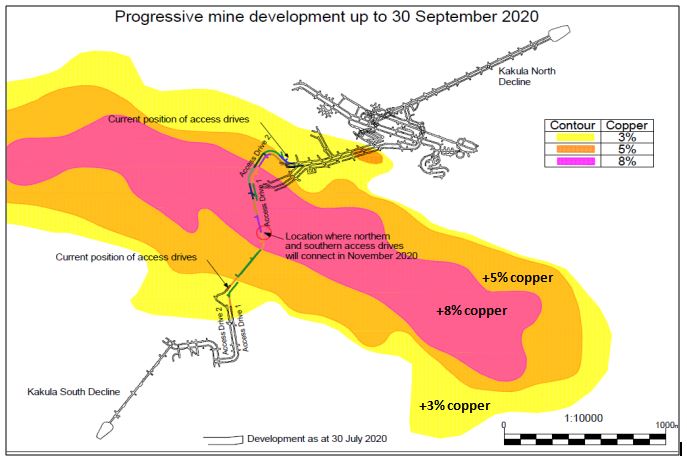
The eastern portion of Kakula Mine ─ representing less than half of the overall 13.3-kilometre-long Kakula Deposit ─ overlain on southern Manhattan Island to give a sense of the enormous scale of the underground operations.

Aerial view of the Kakula Mine showing the tonnes and grade of the main pre-production stockpiles at the northern declines. The high-grade stockpile currently contains approximately 116,000 tonnes grading 6.08% copper, and the medium-grade stockpile currently contains approximately 325,000 tonnes grading 2.94% copper.

Geologist Kally Mbumba showing ultra-high-grade, chalcocite-rich ore at Kakula Mine. Chalcocite has the greatest percentage of copper of all the common sulphide-copper-bearing minerals ─ almost 80% copper by weight.
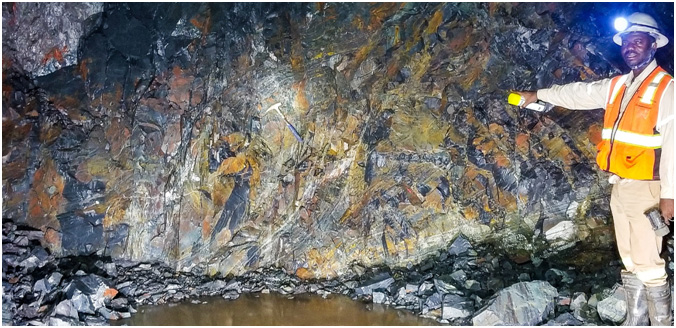
Kakula crews are currently mining and stockpiling ore with an average grade between 3% and 8% copper. At the end of June 2020, Kakula’s high-grade, pre-production ore stockpile contained 67,553 tonnes grading 5.90% copper, the medium-grade ore stockpiles, including satellite stockpiles at Kakula South and Kansoko, contained an additional 394,119 tonnes at 2.71% copper. This has been increased to a high-grade, pre-production ore stockpile containing approximately 116,000 tonnes grading 6.08% copper and medium-grade ore stockpiles containing an additional 446,000 tonnes at 2.73% copper at the end of July 2020. The high-grade stockpile is projected to significantly expand in the coming months as the majority of Kakula’s underground development will be in mining zones grading +5% copper.
Basic engineering design and costing for the expansion from 3.8 Mtpa to 7.6 Mtpa is complete. The scope of facilities includes underground expansion at Kakula to reach an annual production rate of 6 Mtpa, the commencement of mining operations at Kansoko at a steady-state 1.6 Mtpa, a second 3.8 Mtpa concentrator module at Kakula as well as associated surface infrastructure to support the expansion at the various sites.
Ongoing construction of the flotation section of Kakula’s 3.8 Mtpa processing plant.

Ongoing construction of the flotation section of Kakula’s 3.8 Mtpa processing plant.
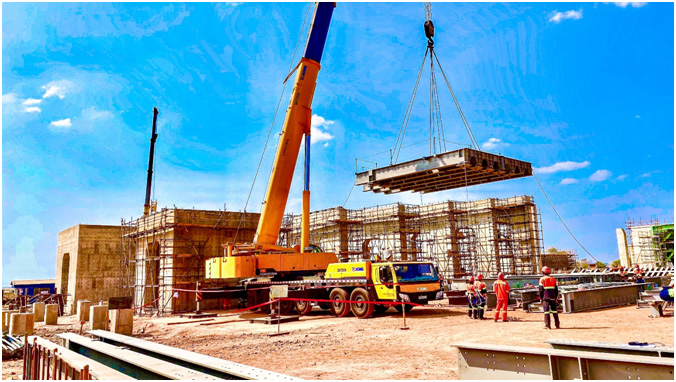
The current estimate of the project’s initial capital costs is approximately $1.3 billion as of January 1, 2019, which assumes commissioning of the first processing plant module in Q3 2021 and includes expanded plant capacity and pre-production ore stockpiles.
The capital costs incurred by the Kamoa-Kakula joint venture in 2019 amounted to $309.1 million, of which $125.2 million was spent on the Kakula declines and mine development. A further capital cost of $242.7 million, that includes the costs allocated to the pre-production ore stockpiles, has been incurred in the six months ended June 30, 2020. Ivanhoe’s share of the capital costs incurred in the six months ended June 30, 2020, was $120 million, representing its share of approximately 40% of the initial capital costs, plus its share of capital associated with the 20% carried interest owned by the Government of the DRC, which will be repaid through future cash flows from the project. Ivanhoe has budgeted $257 million for its proportionate funding of approximately 50% for the Kamoa-Kakula Project for the remainder of 2020. As of June 30, 2020, the joint venture had an estimated $750 million of capital costs remaining until initial production.
Ivanhoe expects that it will continue to have sufficient cash resources or financing options available to cover its proportionate share of the remaining initial capital costs.
More than 18.7 kilometres of underground development now completed as the project tracks towards first production in Q3 2021
A total of 17.1 kilometres of underground development was completed by the end of June 2020, which was 5.2 kilometres ahead of plan. A record of 1.87 kilometres development was achieved in May 2020. At the end of July 2020, more than 18.7 kilometres had been completed.
Mine access drives 1 and 2 (interconnected, parallel tunnels that will provide access to ore zones) continue to advance towards the southern portion of the orebody and are currently developing through the 3% – 5% copper zones. Development also is well advanced on the eastern perimeter drives, western perimeter drives and the room-and-pillar mining area.
Development along south access drives 1 and 2 is progressing well and has reached the 3% – 5% copper zones, with mining crews working to establish the connection of these drives with mine access drives 1 and 2 from the north side of the orebody, this is scheduled to occur in November 2020.
Engineering, procurement and construction advancing well
Project engineering and procurement activities are nearing completion with the focus currently on logistics and construction. The current primary construction focus that runs through the project’s critical path is the construction of the processing plant and the electrical high-voltage infrastructure installation.
Construction of the underground rock handling system is complete with the first rock being conveyed to surface in June 2020.
The civil construction of Ventilation Shaft 2 is underway with fan delivery scheduled in September 2020; the system is expected to be operational before the end of the year. Reaming of Ventilation Shaft North East is expected to start shortly after the completion of the pilot hole. The fan is scheduled to be operational by Q1 2021. Additional material is being procured ahead of the relocation of Ventilation Fan 1 to the North West 1 location.
One of Kakula’s high pressure grinding rolls (HPGR) for the processing plant being offloaded at the port of Durban, South Africa, for transport to Kamoa-Kakula by truck.
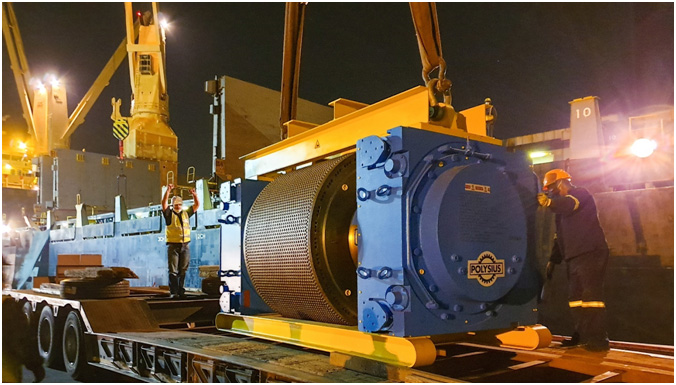
Surveyor, Betty Kabey, scanning the East Spiral drive at the Kakula Mine.

The construction of the dams in the room-and-pillar mining area and the south ventilation shaft central transfer dam is underway; and both of these dams will be complete in Q3 2020.
Civil construction of the process plant is progressing, with over 16,000 cubic metres of concrete already poured. A number of work areas have been completed and handed over for the erection of steel and the installation of mechanical equipment. Steel fabrication in China is nearing completion with the bulk of the steel either delivered to site or being transported. Steel erection has started at the flotation and thickener areas. Fabrication of plate work and piping is well advanced with some material being transported to site.
Manufacture of all long-lead mechanical items is complete with the crushers, low entrainment flotation cells and concentrate filter already delivered to site. Final deliveries for the mills, high pressure grinding rolls (HPGR), flotation cells and thickeners are expected to arrive on-site before the end of August.
Underground pumping station and water dam at Kakula’s 1,050 level. Construction of a second permanent underground water-handling system is progressing well and commissioning is expected this month. The new system will add 800 litres per second of underground pumping capacity, bringing the total installed capacity to 1,400 litres per second.
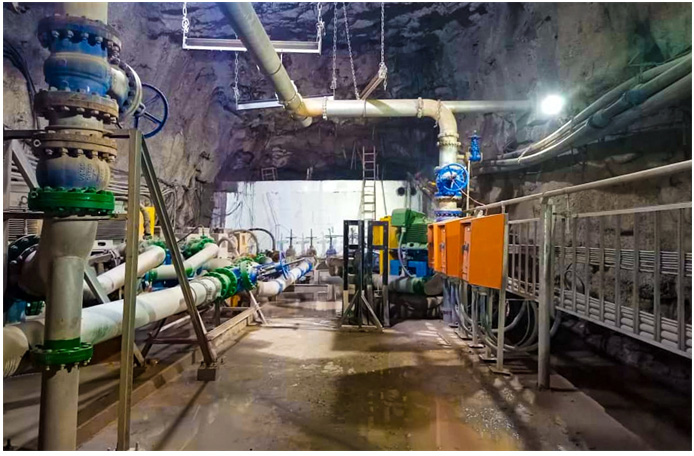
Mukalayi Masengo, Technician, installing bolts on steel support structures for the surface conveyor that will transport ore from the surface stockpiles to the processing plant.
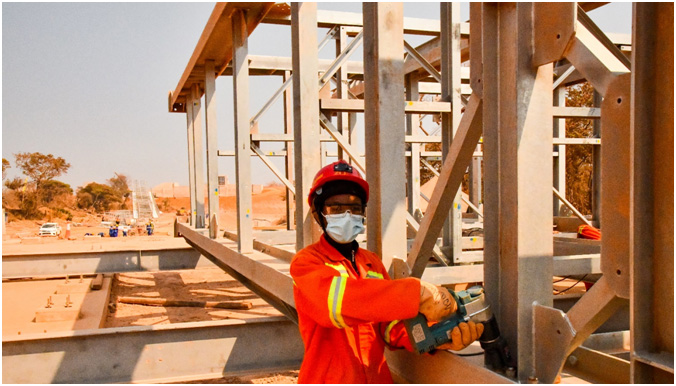
The mine is receiving hydro-generated electrical power for the Kamoa 120kV overhead line via the 18MW mobile substation, which is connected to the national grid. The mobile substation was recently relocated to the Kakula Mine from the Kansoko Mine to increase transmission capacity to Kakula. Construction of the permanent 220-kilovolt overhead power line, the electrical switching substation (NRO substation) and the Kamoa Consumer Substation are underway. The objective is to energize the mine on 220kV grid power early in 2021.
All the newly built accommodation at the Kakula camp has been completed and is occupied. Construction of the kitchen, mess area and laundry will be completed shortly.
Ongoing upgrading work enables Mwadingusha hydropower station to supply clean, sustainable electricity
Ongoing upgrading work at the Mwadingusha hydropower plant in the DRC has significantly progressed. The two main activities remaining are the final installation of the turbines and the completion of the penstock replacement.
Current activities include the installation of the turbine cooling and electrical systems as well as the welding of the valve chambers in the penstocks. Delays were experienced due to some of the European engineers leaving site at the beginning of the COVID-19 pandemic, however these engineers now are returning to site.
The progressive re-commissioning of the turbines is underway with three turbines expected to be in operation by December 2020 and the three remaining turbines in Q1 2021. The refurbished plant is projected to deliver approximately 72 megawatts (MW) of power to the national grid.
The work at Mwadingusha is being conducted by engineering firm STUCKY of Lausanne, Switzerland, under the direction of Ivanhoe Mines and Zijin Mining, in conjunction with the DRC’s state-owned power company, La Société Nationale d’Electricité (SNEL SA).
The Kansoko Mine, Kakula Mine and Kamoa camp have been connected to the national hydroelectric power grid since the completion of a 20-kilometre long, 120-kilovolt, single-circuit power line between Kansoko and SNEL SA’s high voltage national grid in September 2016. A 12-kilometres long, 120-kilovolts, dual-circuit power line between Kansoko and Kakula was completed in December 2017. The design of permanent, 11-kilovolt reticulation to the ventilation shafts and mine has started, which includes substations, overhead lines and surface cables.
The dam at the Mwadingusha hydropower station that will supply clean, sustainable electricity to the DRC national power grid
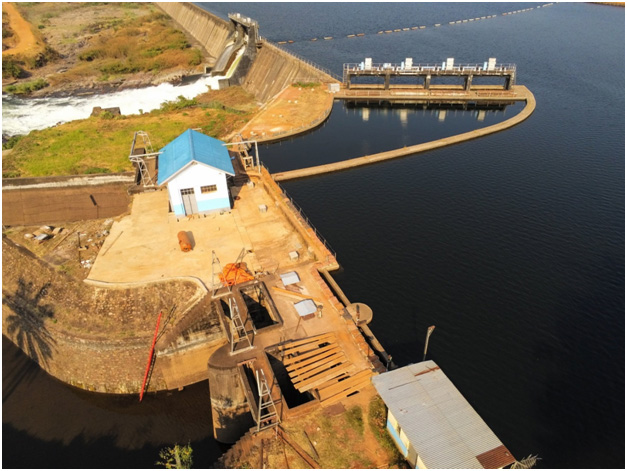
Continued focus on enriching communities through sustainable development
The Kamoa-Kakula Sustainable Livelihoods Program is committed to sustainable development in the communities within the project’s footprint. The main objective of the livelihoods program is to enhance food security and living standards of the people who reside within the project area. The program consists primarily of fish farming, poultry production, beekeeping and food crops; including the farming of maize (corn), vegetables and bananas. With the increase in development activities at the project, a significant number of employment opportunities have also been made available to residents of the local communities.
The Sustainable Livelihoods Program started in 2010 in an effort to strengthen food security and farming capacity in the host communities near Kamoa-Kakula by establishing an agricultural training garden and support for farmers at the community level. Today, approximately 350 community farmers are benefiting from the Sustainable Livelihoods Program, producing high-quality food for their families and selling the surplus for additional income.
Additional non-farming related activities for Q2 2020 included education and literacy programs, the continuation of a community brick-making program and the supply of fresh water to a number of local communities using solar powered boreholes.
Construction of resettlement houses for the second phase of the relocation program is underway. The survey for the final phase of relocation has been completed and crop compensation has commenced, with only five permanent structures being identified. The entire Kakula Mine area, including the tailings dam area, will be secured once these relocation phases are complete.
A farmer weeding in his vegetable nursery.The Livelihoods Program at Kamoa-Kakula has developed into a large-scale operation, with hundreds of beneficiaries raising fish; growing maize and vegetables; and selling poultry and honey.
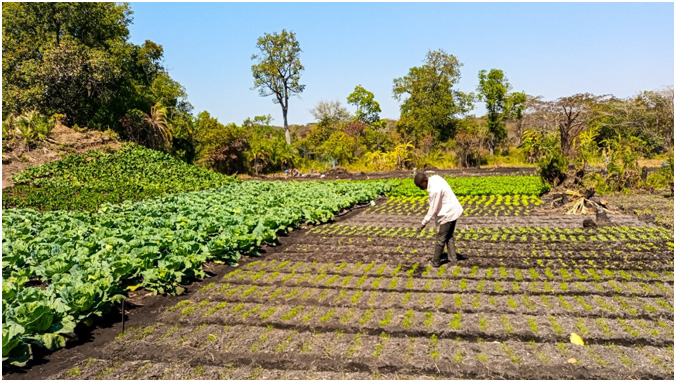
Construction of a community clinic at the local village of Muvunda, a Kamoa-Kakula Livelihoods Program initiative.

2. Platreef Project
64%-owned by Ivanhoe Mines
South Africa
The Platreef Project is owned by Ivanplats (Pty) Ltd (Ivanplats), which is 64%-owned by Ivanhoe Mines. A 26% interest is held by Ivanplats’ historically-disadvantaged, broad-based, black economic empowerment (B-BBEE) partners, which include 20 local host communities with approximately 150,000 people, project employees and local entrepreneurs. Ivanplats reached Level 4 contributor status in its most recent verification assessment on the B-BBEE scorecard. A Japanese consortium of ITOCHU Corporation, Japan Oil, Gas and Metals National Corporation; and Japan Gas Corporation, owns a 10% interest in Ivanplats, which it acquired in two tranches for a total investment of $290 million.
The Platreef Project hosts an underground deposit of thick, platinum-group metals, nickel, copper and gold mineralization on the Northern Limb of the Bushveld Igneous Complex in Limpopo Province – approximately 280 kilometres northeast of Johannesburg and eight kilometres from the town of Mokopane.
On the Northern Limb, platinum-group metals mineralization is hosted primarily within the Platreef, a mineralized sequence that is traced more than 30 kilometres along strike. Ivanhoe’s Platreef Project, within the Platreef’s southern sector, is comprised of two contiguous properties: Turfspruit and Macalacaskop. Turfspruit, the northernmost property, is contiguous with, and along strike from, Anglo Platinum’s Mogalakwena group of mining operations and properties.
Since 2007, Ivanhoe has focused its exploration and development activities on defining and advancing the down-dip extension of its original discovery at Platreef, now known as the Flatreef Deposit, which is amenable to highly mechanized, underground mining methods. The Flatreef area lies entirely on the Turfspruit and Macalacaskop properties, which form part of the company’s mining right.
As part of the company-wide cost-cutting measures announced on April 27, 2020, Ivanhoe’s board of directors allocated a reduced total budget for 2020 of $41.7 million for the Platreef Project, of which $23.4 million remains for the balance of the year. The sinking of Platreef’s Shaft 1 has recently been completed, enabling Shaft 1 to be configured for permanent rock hoisting.
Health and safety at Platreef
At the end of Q2 2020, the Platreef Project reached a total of 119,686 lost-time, injury-free hours worked in accordance with South Africa’s Mine Health and Safety Act, and Occupational Health and Safety Act.
The last lost-time injury (LTI) occurred on May 18, 2020. The Platreef Project has noted an 80% improvement in the total recordable injury frequency rate (TRIFR) year on year with only one Recordable Injury for 2020.
In response to the country-wide lock down imposed by the South African Government due to the COVID-19 pandemic, Platreef temporarily suspended its shaft-sinking operations on March 26, 2020. During the suspension, the project kept a small workforce to keep the operation ready for when development resumed. Since April 21, 2020, following the announcement of amended regulations authorizing South African mines to operate at a workforce capacity of 50%, site activities resumed under strict mitigation controls.
One employee tested positive for COVID-19 in mid-July and was immediately placed in the project’s quarantine facilities that have been set up in close proximity to the minesite. Contact tracing also was performed with direct contacts also being isolated.
Platreef phased development plan and update of Definitive Feasibility Study
Ivanhoe is investigating a phased development plan for the Platreef Project, targeting significantly lower initial capital, to accelerate first production by using Shaft 1 as the mine’s initial production shaft. This plan will focus on initially targeting the development of mining zones accessible from Shaft 1 and maximizing the hoisting capacity of this shaft, followed by expansions to the production rate as outlined in the 2017 DFS.
Concurrently, Ivanhoe is updating the Platreef Project’s DFS to take into account development schedule advancement since 2017 when the DFS was completed, updated costs and refreshed metal prices and foreign exchange assumptions. This update, together with the study on the phased development plan, is scheduled for completion in Q3 2020.
Shaft 1 successfully completed down to the final depth of 996 metres
Shaft 1 reached the top of the high-grade Flatreef Deposit (T1 mineralized zone) at a depth of 780.2 metres below surface in Q3 2018 and has since been extended to its final depth of 996 metres below surface. The thickness of the mineralized orebody (T1 and T2 mineralized zones) at Shaft 1 is 29 metres, with grades of platinum-group metals ranging up to 11 grams per tonne (g/t) 3PE (platinum, palladium and rhodium) plus gold, as well as significant quantities of nickel and copper. The 29-metre intersection yielded approximately 3,000 tonnes of ore, estimated to contain more than 400 ounces of platinum-group metals. The ore is stockpiled on surface for further metallurgical sampling.
Members of the Platreef team celebrate the completion of sinking Shaft 1 to a final depth of 996 metres below surface. Shaft 1’s headframe is in the background.
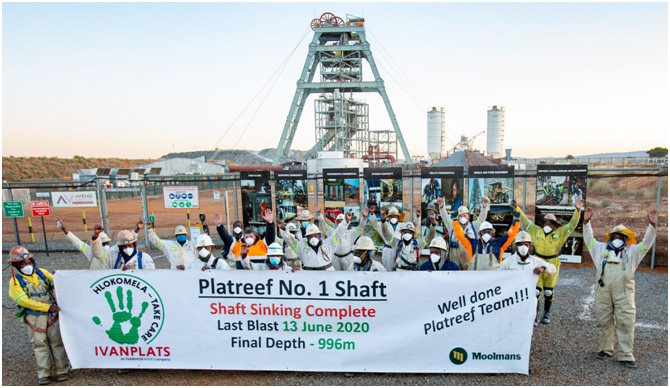
Schematic section of the Platreef Mine, showing Flatreef’s T1 and T2 thick, high-grade mineralized zones (red and dark orange), underground development work completed to date in shafts 1 and 2 (white) and planned development work (gray).

The 750, 850 and 950-metre-level station developments have been completed. The three development stations will provide initial, underground access to the high-grade orebody. Shaft 1 changeover detailed designs are nearing completion and will enable Shaft 1 to be configured for permanent rock hoisting.
Underground mining to incorporate highly-productive, mechanized methods
The mining zones in the current Platreef mine plan occur at depths ranging from approximately 700 metres to 1,200 metres below surface. When completed, Shaft 2 is expected to provide primary access to the mining zones; secondary access is expected to be via Shaft 1. During mine production, both shafts also are expected to serve as ventilation intakes. Three additional ventilation exhaust raises are planned to achieve steady-state production.
Planned mining methods will use highly-productive, mechanized methods, including long-hole stoping and drift-and-fill mining. Each method will utilize cemented backfill for maximum ore extraction. The ore will be hauled from the stopes to a series of internal ore passes and fed to the bottom of Shaft 2, where it will be crushed and hoisted to surface.
In June, Platreef’s shaft-sinking team drilled the final round to a depth of 996 metres below surface.
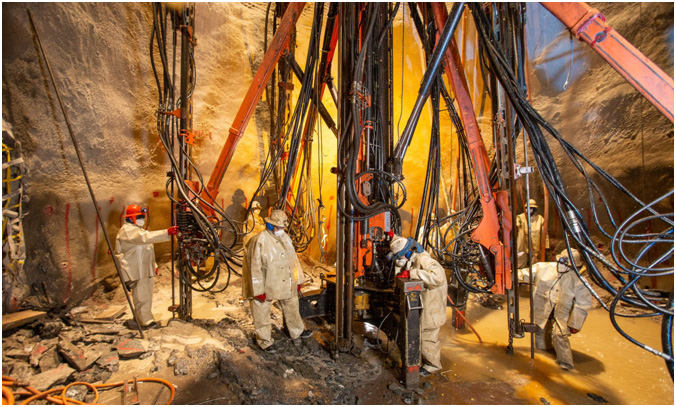
Development of human resources and job skills
Consultation regarding the Platreef Project’s second Social and Labour Plan (SLP) is in the final stages. In this second SLP, Ivanplats plans to build on the foundation laid in the first SLP and continue with its training and development suite, which includes: 15 new mentors; internal skills training for 78 staff members; a legends program to prepare retiring employees with new/other skills; community adult education training for our host community members; core technical skills training for at least 100 community members, portable skills; and more.
Local economic development projects will contribute community water source development with the Municipality boreholes program, educational program in partnership with Department of Education and significant contribution funding for sanitation infrastructure at the Mogalakwena Municipality. The enterprise and supplier development commitments comprise of expanding the existing kiosk and laundry facilities even further, also adding expanded change house facilities to be managed by a community partner in future. A five year integrated business accelerator and funding project will assist community members interested to obtain help with development and supplier readiness.
3. Kipushi Project
68%-owned by Ivanhoe Mines
Democratic Republic of Congo
The Kipushi copper-zinc-germanium-silver-lead mine, in the DRC, is adjacent to the town of Kipushi and approximately 30 kilometres southwest of Lubumbashi. It is located on the Central African Copperbelt, approximately 250 kilometres southeast of the Kamoa-Kakula Project and less than one kilometre from the Zambian border. Ivanhoe acquired its 68% interest in the Kipushi Project in November 2011; the balance of 32% is held by the state-owned mining company, Gécamines.
As part of the company’s cost-cutting measures announced on April 27, 2020, Ivanhoe’s board of directors allocated a reduced total budget for 2020 of $28.7 million for the Kipushi Project, of which approximately $13.5 million remains for the rest of the year.
Health, safety and community development
At the end of June 2020, the Kipushi Project reached a total of 2,489,853 work hours free of lost-time injuries. It has been more than 19 months since the last lost-time injury occurred at the Kipushi Project.
In response to government-imposed travel restrictions and emergency protocols being introduced worldwide due to the COVID-19 pandemic, Kipushi has temporarily suspended mine development operations in order to reduce the risk to the workforce and local communities. The project is maintaining a reduced workforce to conduct maintenance activities and to maintain pumping operations.
The Kipushi Project operates a potable-water station to supply the municipality of Kipushi with water. This includes power supply, disinfectant chemicals, routine maintenance, security, and emergency repair of leaks to the primary reticulation. Other community development projects included the donation of 5,000 N95 face masks to host communities, the donation of additional infrared thermometers to the Health Zone management and sponsoring a COVID-19 awareness campaign broadcast on local radio. The sewing training centre project started production of cloth face masks with the target of donating 2,000 masks every month to host communities.
Definitive feasibility study in final stages of completion
The Kipushi Project’s pre-feasibility study (PFS), announced by Ivanhoe Mines on December 13, 2017, anticipated annual production of an average of 381,000 tonnes of zinc concentrate over an 11-year, initial mine life at a total cash cost of approximately $0.48 per pound (lb) of zinc.
Highlights of the PFS, based on a long-term zinc price of $1.10/lb, include:
- After-tax net present value (NPV) at an 8% real discount rate of $683 million.
- After-tax real internal rate of return (IRR) of 35.3%.
- After-tax project payback period of 2.2 years.
- Pre-production capital costs, including contingency, of $337 million.
- Existing surface and underground infrastructure allows for significantly lower capital costs than comparable greenfield development projects.
- Life-of-mine average planned zinc concentrate production of 381,000 dry tonnes per annum, with a concentrate grade of 59% zinc, is expected to rank Kipushi, once in production, among the world’s largest zinc mines.
All figures are on a 100%-project basis unless otherwise stated. Estimated life-of-mine average cash cost of $0.48/lb of zinc is expected to rank Kipushi, once in production, in the bottom quartile of the cash-cost curve for zinc producers internationally.
The Kipushi Project’s DFS is in the final stages of completion, and some aspects of the design have progressed into a detailed engineering phase.
Samuel Ndembo (left) and Mbiya Africa (right) taking air flow measurements at Kipushi’s 850-metre-level electrical substation.
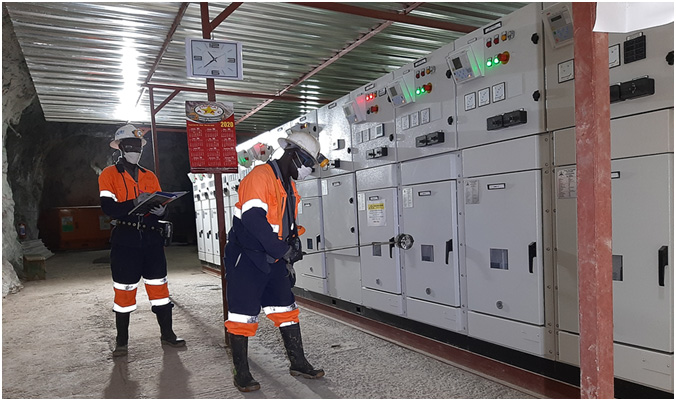
Project development and infrastructure
Although development and rehabilitation activities in the six months ending June 2020 were limited, significant progress has been made in recent years modernizing the Kipushi Mine’s underground infrastructure as part of preparations for the mine to resume commercial production, including upgrading a series of vertical mine shafts to various depths, with associated head frames, as well as underground mine excavations and infrastructure. A series of crosscuts and ventilation infrastructure still is in working condition and have been cleared of old materials and equipment to facilitate modern, bulk-mechanized mining. The underground infrastructure also includes a series of high-capacity pumps to manage the mine’s water levels, which now are easily maintained at the bottom of the mine.
Shaft 5 is eight metres in diameter and 1,240 metres deep and has been upgraded and re-commissioned. The main personnel and material winder has been upgraded and modernized to meet international industry standards and safety criteria. The Shaft 5 rock-hoisting winder also is fully operational with new rock skips, new head- and tail-ropes, and attachments installed. The two newly-manufactured rock conveyances (skips) and the supporting frames (bridles) have been installed in the shaft to facilitate the hoisting of rock from the main ore and waste storage silos feeding rock on the 1,200-metre level.
The main haulage way on the 1,150-metre level, between the Big Zinc access decline and Shaft 5 rock load-out facilities, has been resurfaced with concrete so the mine now can use modern, trackless, mobile machinery. A new truck-tipping bin, which feeds into the large-capacity rock crusher located directly below, has been installed on this level. The old winder at P2 Shaft has been removed and construction of the new foundation, along with assembly and installation of the new modern winder, has been completed and fully commissioned after passing safety inspection and testing procedures.
4. DRC Western Foreland Exploration Project
100%-owned by Ivanhoe Mines
Democratic Republic of Congo
Ivanhoe’s DRC exploration group is targeting Kamoa-Kakula-style copper mineralization through a regional exploration and drilling program on its 100%-owned Western Foreland exploration licences, located to the north, south and west of the Kamoa-Kakula Project. Exploration activities on the Western Foreland’s exploration project in DRC will continue with a 2020 budget of $8 million, of which approximately $4.5 million remains for the rest of the year.
In Q1 2020, six holes were drilled at the at Makoko prospect, totalling of 2,103 metres. In late Q1, drilling was suspended on the Western Foreland exploration licences due to excessive rains hampering access to drilling sites and in response to the preventative measures implemented by the company to protect its employees and drilling contractors from COVID-19. During Q2 2020, the geology team commenced exploration on eight new Ivanhoe Mines exploration licences (PR14543 – PR14550) in the Western Foreland region. This work involved establishing an exploration centre on each of the licences, and conducting a minimum of ten days, ground-based geological work, focused on channel and field mapping and stream and grab sampling. Follow up work on licences PR14546 and PR14547 continued after the submission of seven exploration reports to the DRC government.
High-resolution satellite imagery, aster data and 2.5-metre resolution Digital Elevation Model (DEM) data was acquired over the Western Foreland licence area. Planning for a high-resolution magnetic and radiometric survey was completed, and planning for an airborne gravity survey is ongoing. Both geophysical surveys are planned to commence in Q3 2020. The goal of this work is to understand the magnetic and density characteristics of the different lithologies and stratigraphy over the broader exploration area.
SELECTED QUARTERLY FINANCIAL INFORMATION
The following table summarizes selected financial information for the prior eight quarters. Ivanhoe had no operating revenue in any financial reporting period and did not declare or pay any dividend or distribution in any financial reporting period.

DISCUSSION OF RESULTS OF OPERATIONS
Review of the three months ended June 30, 2020 vs. June 30, 2019
The company recorded a total comprehensive income of $0.3 million for Q2 2020 compared to an income of $8.1 million for the same period in 2019.
Salary and benefits of $5.1 million for the three months ended June 30, 2020 was $2.8 million for the same period in 2019. The increase was due to the severance payments made to outgoing members of senior management, as the company reduced its senior management headcount. This was partly offset by the voluntary salary reductions agreed to by remaining senior management.
Finance income for Q2 2020, amounted to $18.7 million, and was $1.8 million more than for the same period in 2019 ($16.9 million). Included in finance income is the interest earned on loans to the Kamoa Holding joint venture to fund operations that amounted to $16.4 million for Q2 2020, and $12.7 million for the same period in 2019, interest increased as the accumulated loan balance increased. Interest received on cash and cash equivalents decreased due to interest rate cuts by the US Federal Reserve, even though the company had a higher cash balance during Q2 2020.
Exploration and project expenditure amounted to $9.0 million in Q2 2020 and $3.3 million for the same period in 2019. While all the exploration and project expenditure incurred in Q2 2019 related to exploration at Ivanhoe’s 100%-owned Western Foreland exploration licences, Q2 2020 also included $7.5 million spent at the Kipushi Project which incurred limited costs of a capital nature in the quarter due to reduced activities. The main classes of expenditure at the Kipushi Project in Q2 2020 and Q2 2019 are set out in the following table:
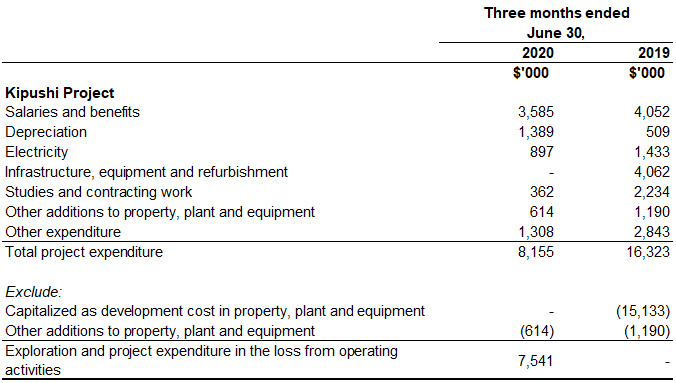
The company’s share of losses from the Kamoa Holding joint venture increased from $6.2 million in Q2 2019 to $6.6 million in Q2 2020. The following table summarizes the company’s share of the losses of Kamoa Holding for the three months ended June 30, 2020, and for the same period in 2019:
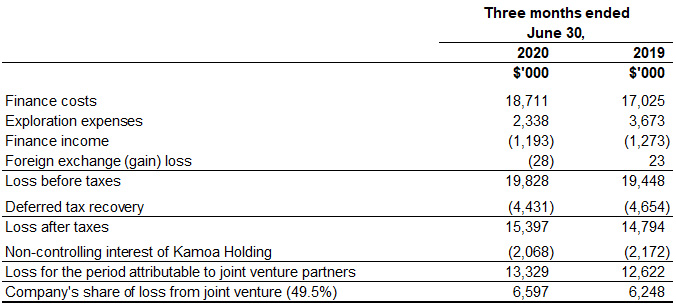
The finance costs in the Kamoa Holding joint venture relates to shareholder loans where each shareholder is required to fund Kamoa Holding in an amount equivalent to its proportionate shareholding interest. The company is advancing Crystal River’s portion on its behalf in return for an increase in the promissory note due to Ivanhoe.
Review of the six months ended June 30, 2020 vs. June 30, 2019
The company recorded a total comprehensive loss of $76.3 million for the six months ended June 30, 2020 compared to an income of $11.5 million for the same period in 2019. The comprehensive loss for the six months ended June 30, 2020 included an exchange loss on translation of foreign operations of $53.9 million, resulting from the weakening of the South African Rand by 24% from December 31, 2019, to June 30, 2020, compared to an exchange gain on translation of foreign operations recognized for the same period in 2019 of $5.8 million.
Finance income for the six months ended June 30, 2020, amounted to $39.5 million, and was $6.8 million more than for the same period in 2019 ($32.7 million). Included in finance income is the interest earned on loans to the Kamoa Holding joint venture to fund operations that amounted to $32.7 million for the six months ended June 30, 2020, and $24.7 million for the same period in 2019, interest increased as the accumulated loan balance increased. Interest received on cash and cash equivalents for the six months ended June 30, 2020 amounted to $3.5 million and was $2.6 million less than for the same period in 2019 ($6.1 million).
Exploration and project expenditure amounted to $21.0 million for the six months ended June 30, 2020 and $4.7 million for the same period in 2019. While all the exploration and project expenditure incurred in 2019 related to exploration at Ivanhoe’s 100%-owned Western Foreland exploration licences, 2020 also included $17.5 million spent at the Kipushi Project which was on reduced activities and incurred limited cost of a capital nature in the year to date. The main classes of expenditure at the Kipushi Project for the six months ended June 30, 2020, and for the same period in 2019 are set out in the following table:
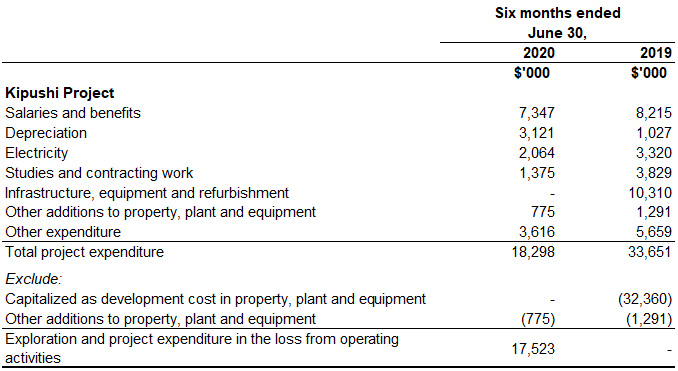
The company’s share of losses from the Kamoa Holding joint venture increased from $12.1 million for the six months ended June 30, 2019 to $13.3 million for the same period 2020. The following table summarizes the company’s share of the losses of Kamoa Holding for the six months ended June 30 2020, and for the same period in 2019:
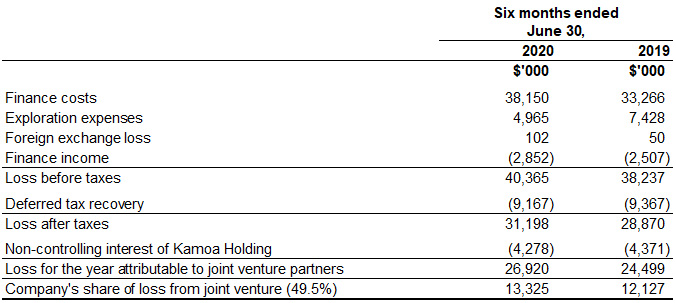
Financial position as at June 30, 2020 vs. December 31, 2019
The company’s total assets decreased by $76.7 million, from $2,444.7 million as at December 31, 2019, to $2,368.0 million as at June 30, 2020. The company utilized $37.5 million of its cash resources in its operations and received interest of $3.5 million on cash and cash equivalents during the six months ended June 30 2020.
Property, plant and equipment decreased by $34.0 million, from $421.1 million as at December 31, 2019, to $387.1 million as at June 30, 2020. The decrease resulted from the foreign exchange translation of property, plant and equipment of non-dollar operations of $51.6 million due to the weakening of the South African Rand by 24% from December 31, 2019, to June 30, 2020. A total of $19.8 million was spent on project development and to acquire other property, plant and equipment, $18.5 million of which pertained to development costs and other acquisitions of property, plant and equipment at the Platreef Project.
The main components of the additions to property, plant and equipment – including capitalized development costs – at the Platreef Project for the six months ended June 30, 2020, and for the same period in 2019, are set out in the following table:
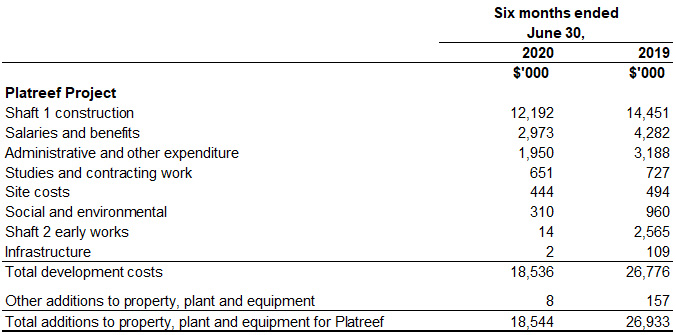
Costs incurred at the Platreef Project are deemed necessary to bring the project to commercial production and are therefore capitalized as property, plant and equipment.
The company’s investment in the Kamoa Holding joint venture increased by $162.4 million from $912.6 million as at December 31, 2019, to $1,075.0 million as at June 30, 2020, with each of the current shareholders funding the operations equivalent to their proportionate shareholding interest. The company’s portion of the Kamoa Holding joint venture cash calls amounted to $143.0 million during the six months ending June 30, 2020, while the company’s share of losses from the joint venture amounted to $13.3 million.
The company’s investment in the Kamoa Holding joint venture can be broken down as follows:

The Kamoa Holding joint venture principally uses loans advanced to it by its shareholders to advance the Kamoa-Kakula Project through investing in development costs and other property, plant and equipment, as well as continuing with exploration. This can be evidenced by the movement in the company’s share of net assets in the Kamoa Holding joint venture which can be broken down as follows:
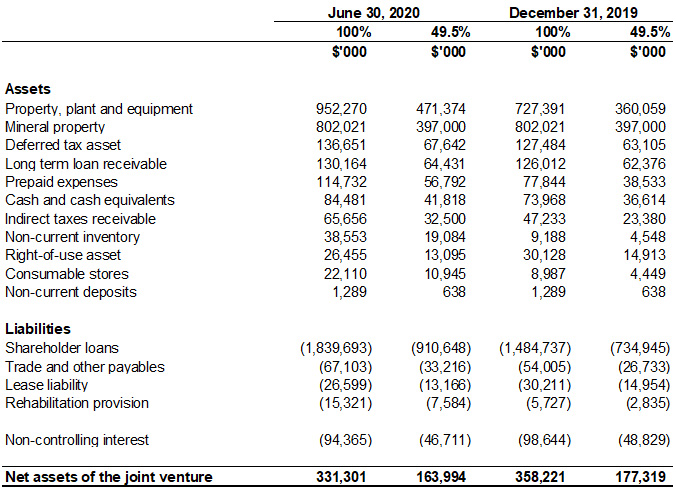
The Kamoa Holding joint venture’s net increase in property, plant and equipment from December 31, 2019, to June 30, 2020, amounted to $224.9 million and can be further broken down as follows:
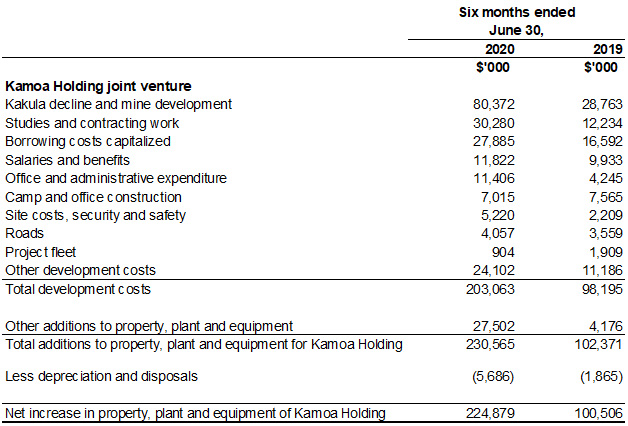
The company’s total liabilities decreased by $10.1 million to $71.8 million as at June 30, 2020, from $81.9 million as at December 31, 2019, due to a $10.4 million decrease in trade and other payables.
LIQUIDITY AND CAPITAL RESOURCES
The company had $496.2 million in cash and cash equivalents as at June 30, 2020. At this date, the company had consolidated working capital of approximately $544.8 million, compared to $688.5 million at December 31, 2019.
Since December 8, 2015, each shareholder in Kamoa Holding has been required to fund Kamoa Holding in an amount equivalent to its proportionate shareholding interest. The company is advancing Crystal River’s portion on its behalf in return for an increase in the promissory note due to Ivanhoe.
The Platreef Project’s current expenditure is being funded solely by Ivanhoe, through an interest bearing loan to Ivanplats, as the Japanese consortium has elected not to contribute to current expenditures.
The company is in the process of reducing its global office footprint and its corporate and senior management headcount, in addition to implementing several other company-wide, cash-saving measures. Ivanhoe’s head office will remain in Sandton (South Africa) and be supported by satellite offices in Beijing (China) and London (United Kingdom). The company has budgeted to spend $11.1 million on corporate overheads for the remainder of 2020.
Ivanhoe’s board of directors allocated a reduced 2020 budget of $41.7 million for the Platreef Project, of which $23.4 million is allocated for the remainder of 2020, where the sinking of Platreef’s Shaft 1 has recently been completed. The company also allocated a reduced 2020 budget of $28.7 million for the Kipushi Project, of which $13.5 million is allocated for the remainder of 2020. Exploration activities on the Western Foreland’s exploration project in DRC will continue with a 2020 budget of $8.0 million, of which $4.5 million is allocated for the remainder of 2020. At the Kamoa-Kakula Project, the priority remains the continuation of mine development work at Kakula where initial copper concentrate production is scheduled for the third quarter of 2021. The company has budgeted $257 million for its proportionate funding of the Kamoa-Kakula Project for the remainder of 2020.
As Ivanhoe continues to advance its projects, the company’s management has reviewed and assessed numerous alternatives to finance its share of construction costs for the Kakula Copper Mine and to advance exploration and development initiatives at its other projects in Southern Africa. These alternatives include, but are not limited to, existing liquidity sources, including cash, receivables and investments, selling assets, project financing, streaming or royalty transactions, equipment and debt financing. While Ivanhoe expects that it will continue to have sufficient cash resources or project-related financing options available to cover its share of the initial capital costs at the Kakula Mine, the company will continue to seek out and review opportunities presented to Ivanhoe, having regard to the best interests of Ivanhoe as well as to Ivanhoe’s operations and financial position, industry conditions and geopolitical considerations.
This news release should be read in conjunction with Ivanhoe Mines’ unaudited condensed consolidated interim financial statements and Management’s Discussion and Analysis report for the three and six months ended June 30, 2020 available at www.ivanhoemines.com and at www.sedar.com.
Qualified Person
Disclosures of a scientific or technical nature regarding the revised capital expenditure and development scenarios at the Kamoa-Kakula Project in this news release have been reviewed and approved by Steve Amos, who is considered, by virtue of his education, experience and professional association, a Qualified Person under the terms of NI 43-101. Mr. Amos is not considered independent under NI 43-101 as he is the Head of the Kamoa Project. Mr. Amos has verified the technical data disclosed in this news release.
Other disclosures of a scientific or technical nature in this news release have been reviewed and approved by Stephen Torr, who is considered, by virtue of his education, experience and professional association, a Qualified Person under the terms of NI 43-101. Mr. Torr is not considered independent under NI 43-101 as he is the Vice President, Project Geology and Evaluation. Mr. Torr has verified the other technical data disclosed in this news release.
Ivanhoe has prepared a current, independent, NI 43-101-compliant technical report for each of the Platreef Project, the Kipushi Project and the Kamoa-Kakula Project, which are available under the company’s SEDAR profile at www.sedar.com:
- The Kamoa-Kakula 2020 Resource Update dated March 25, 2020, prepared by OreWin Pty Ltd., Wood plc, DRA Global, SRK Consulting (South Africa) (Pty) Ltd and Stantec Consulting International LLC, covering the Company’s Kamoa-Kakula Project;
- The Platreef 2017 Feasibility Study Technical Report dated September 4, 2017, prepared by DRA Global, OreWin Pty. Ltd., Amec Foster Wheeler, Stantec Consulting, Murray & Roberts Cementation, SRK Consulting, Golder Associates, and Digby Wells Environmental, covering the company’s Platreef Project; and
- The Kipushi 2019 Mineral Resource Update dated March 28, 2019, prepared by OreWin Pty Ltd., MSA Group (Pty) Ltd., SRK Consulting (South Africa) (Pty) Ltd and MDM (Technical) Africa Pty Ltd. (a division of Wood PLC), covering the company’s Kipushi Project.
These technical reports include relevant information regarding the effective dates and the assumptions, parameters and methods of the mineral resource estimates on the Platreef Project, the Kipushi Project and the Kamoa-Kakula Project cited in this news release, as well as information regarding data verification, exploration procedures and other matters relevant to the scientific and technical disclosure contained in this news release in respect of the Platreef Project, Kipushi Project and Kamoa-Kakula Project. Additional information regarding the company, including the company’s Annual Information Form, is available on SEDAR at www.sedar.com.
Information contacts
Investors
Bill Trenaman +1.604.331.9834
Media
Matthew Keevil +1.604. 558.1034
Website www.ivanhoemines.com
Forward-looking statements
Certain statements in this news release constitute “forward-looking statements” or “forward-looking information” within the meaning of applicable securities laws. Such statements and information involve known and unknown risks, uncertainties and other factors that may cause the actual results, performance or achievements of the company, its projects, or industry results, to be materially different from any future results, performance or achievements expressed or implied by such forward-looking statements or information. Such statements can be identified by the use of words such as “may”, “would”, “could”, “will”, “intend”, “expect”, “believe”, “plan”, “anticipate”, “estimate”, “scheduled”, “forecast”, “predict” and other similar terminology, or state that certain actions, events or results “may”, “could”, “would”, “might” or “will” be taken, occur or be achieved. These statements reflect the company’s current expectations regarding future events, performance and results and speak only as of the date of the company’s Q2 2020 MD&A.
Such statements include without limitation, the timing and results of: (i) statements regarding first copper concentrate production at the Kakula Mine in Q3 2021; (ii) statements regarding the pace of underground development at the Kakula Mine is expected to continue to accelerate as additional mining crews are mobilized; (iii) statements regarding Kakula’s high-grade stockpile is projected to significantly expand in the coming months as the majority of Kakula’s underground development will be in mining zones grading +5% copper; (iv) statements regarding the expectation that Kakula’s high pressure grinding rolls (HPGR), flotation cells and thickeners are expected to arrive on site before the end of August 2020; (v) statements regarding refurbishment of six turbines at the Mwadingusha hydro-electric power plant and associated 220-kilovolt infrastructure is progressing and that three turbines are expected to be operational by December 2020, the remaining three in Q1 2021, and the refurbished plant is projected to deliver approximately 72 megawatts of power to the national grid; (vi) statements regarding a phased development production plan for the Platreef Project that targets significantly lower initial capital, to accelerate first production by using Shaft 1 as the mine’s initial production shaft, followed by expansions to the production rate as outlined in the 2017 definitive feasibility study (DFS); (vii) statements regarding the planned expansion in initial plant capacity at Kakula from 3.0 Mtpa to 3.8 Mtpa and the planned increase in the underground mining crews in 2020 from 11 to 14 to ensure sufficient mining operations to feed the expanded plant throughput; (viii) statements regarding the updated estimate of Kakula’s initial capital costs is approximately $1.3 billion as of January 1, 2019, which assumes commissioning of the processing plant in Q3 2021 and includes expanded plant capacity and pre-production ore stockpiles; (ix) statements that the Kamoa-Kakula joint venture had an estimated $750 million of capital costs remaining until initial production; (x) statements regarding the planned mining methods at Platreef will use highly productive, mechanized methods, including long-hole stoping and drift-and-fill mining, and that each method will utilize cemented backfill for maximum ore extraction; (xi) statements regarding an independent DFS for the Kakula Mine is well advanced and is expected to be finalized shortly, and at the same time, Ivanhoe expects to issue an Integrated Development Plan for the entire Kamoa-Kakula mining complex, which will include details on the planned expansion phases for the greater Kamoa-Kakula mining complex, incorporating updates for mineral resources, production rates and economic analysis; (xii) statements regarding the forthcoming Kakula DFS will incorporate detailed design, engineering and procurement, with the plans to increase the initial processing plant ore capacity from 3.0 Mtpa to 3.8 Mtpa; (xiii) statements regarding Ivanhoe’s expectation that it will continue to have sufficient cash resources or project-related financing options available to cover its share of the initial capital costs; (xiv) statements regarding timing and duration of reduced activities at the Platreef and Kipushi projects; (xv) statements regarding the expected expenditure for the remainder of 2020 of $23.4 million on further development at the Platreef Project; $13.5 million at the Kipushi Project; $4.5 million on regional exploration in the DRC; and $11.1 million on corporate overheads – as well as its proportionate funding of the Kamoa-Kakula Project, expected to be $257 million for the remainder of 2020.
As well, all of the results of the pre-feasibility study for the Kakula copper mine and the updated and expanded Kamoa-Kakula Project preliminary economic assessment, the feasibility study of the Platreef Project and the pre-feasibility study of the Kipushi Project, constitute forward-looking statements or information, and include future estimates of internal rates of return, net present value, future production, estimates of cash cost, proposed mining plans and methods, mine life estimates, cash flow forecasts, metal recoveries, estimates of capital and operating costs and the size and timing of phased development of the projects. Furthermore, with respect to this specific forward-looking information concerning the development of the Kamoa-Kakula, Platreef and Kipushi projects, the company has based its assumptions and analysis on certain factors that are inherently uncertain. Uncertainties include: (i) the adequacy of infrastructure; (ii) geological characteristics; (iii) metallurgical characteristics of the mineralization; (iv) the ability to develop adequate processing capacity; (v) the price of copper, nickel, zinc, platinum, palladium, rhodium and gold; (vi) the availability of equipment and facilities necessary to complete development; (vii) the cost of consumables and mining and processing equipment; (viii) unforeseen technological and engineering problems; (ix) accidents or acts of sabotage or terrorism; (x) currency fluctuations; (xi) changes in regulations; (xii) the compliance by joint venture partners with terms of agreements; (xiii) the availability and productivity of skilled labour; (xiv) the regulation of the mining industry by various governmental agencies; (xv) the ability to raise sufficient capital to develop such projects; (xiv) changes in project scope or design, and (xv) political factors.
This news release also contains references to estimates of Mineral Resources and Mineral Reserves. The estimation of Mineral Resources is inherently uncertain and involves subjective judgments about many relevant factors. Estimates of Mineral Reserves provide more certainty but still involve similar subjective judgments. Mineral Resources that are not Mineral Reserves do not have demonstrated economic viability. The accuracy of any such estimates is a function of the quantity and quality of available data, and of the assumptions made and judgments used in engineering and geological interpretation (including estimated future production from the company’s projects, the anticipated tonnages and grades that will be mined and the estimated level of recovery that will be realized), which may prove to be unreliable and depend, to a certain extent, upon the analysis of drilling results and statistical inferences that ultimately may prove to be inaccurate. Mineral Resource or Mineral Reserve estimates may have to be re-estimated based on: (i) fluctuations in copper, nickel, zinc, platinum group elements (PGE), gold or other mineral prices; (ii) results of drilling; (iii) metallurgical testing and other studies; (iv) proposed mining operations, including dilution; (v) the evaluation of mine plans subsequent to the date of any estimates and/or changes in mine plans; (vi) the possible failure to receive required permits, approvals and licences; and (vii) changes in law or regulation.
Forward-looking statements and information involve significant risks and uncertainties, should not be read as guarantees of future performance or results and will not necessarily be accurate indicators of whether or not such results will be achieved. A number of factors could cause actual results to differ materially from the results discussed in the forward-looking statements or information, including, but not limited to, the factors discussed below and under “Risk Factors”, and elsewhere in the company’s MD&A for the three and six months ended June 30, 2020, as well as unexpected changes in laws, rules or regulations, or their enforcement by applicable authorities; the failure of parties to contracts with the company to perform as agreed; social or labour unrest; changes in commodity prices; and the failure of exploration programs or studies to deliver anticipated results or results that would justify and support continued exploration, studies, development or operations.
Although the forward-looking statements contained in this news release are based upon what management of the company believes are reasonable assumptions, the company cannot assure investors that actual results will be consistent with these forward-looking statements. These forward-looking statements are made as of the date of this news release and are expressly qualified in their entirety by this cautionary statement. Subject to applicable securities laws, the company does not assume any obligation to update or revise the forward-looking statements contained herein to reflect events or circumstances occurring after the date of this news release.
The company’s actual results could differ materially from those anticipated in these forward-looking statements as a result of the factors set forth in the “Risk Factors” section and elsewhere in the company’s MD&A for the three and six months ended June 30, 2020.


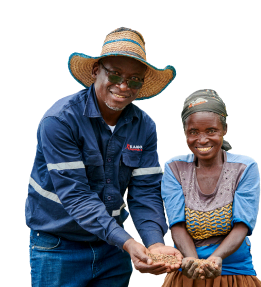
 English
English Français
Français 日本語
日本語 中文
中文